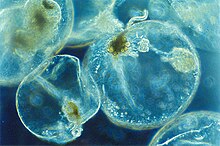species of protist From Wikipedia, the free encyclopedia
Noctiluca scintillans, is the sea sparkle.[1] It is a free-living marine-dwelling species of dinoflagellate.
| Noctiluca scintillans | |
|---|---|
 | |
| Scientific classification | |
| Domain: | |
| Order: | Noctilucales |
| Family: | Noctilucaceae |
| Genus: | Noctiluca |
| Species: | N. scintillans |
| Binomial name | |
| Noctiluca scintillans (Macartney) Kofoid & Swezy, 1921 | |
| Synonyms | |
|
Noctiluca miliaris | |

It shows bioluminescence when disturbed: this produces a "milky seas effect". The bioluminescence is produced in the cytoplasm of this single-celled protist. It is done by a luciferin-luciferase reaction in thousands of spherical organelles, called scintillons. Nonluminescent populations in the genus Noctiluca lack these scintillons.
Noctiluca is a heterotroph (non-photosynthetic) that engulfs by phagocytosis. They eat plankton, diatoms, other dinoflagellates, fish eggs and bacteria. The diatom Thalassiosira is known as a favourite food source of Noctiluca.
N. scintillans also takes in tiny phytoplankton which live as endosymbionts. They do photosynthesis for their larger host. Diatoms are often found in the vacuoles (internal membrane-bound storage compartments) of Noctiluca. The green non-feeding symbionts can grow photoautotrophically for generations.[2]
Seamless Wikipedia browsing. On steroids.
Every time you click a link to Wikipedia, Wiktionary or Wikiquote in your browser's search results, it will show the modern Wikiwand interface.
Wikiwand extension is a five stars, simple, with minimum permission required to keep your browsing private, safe and transparent.